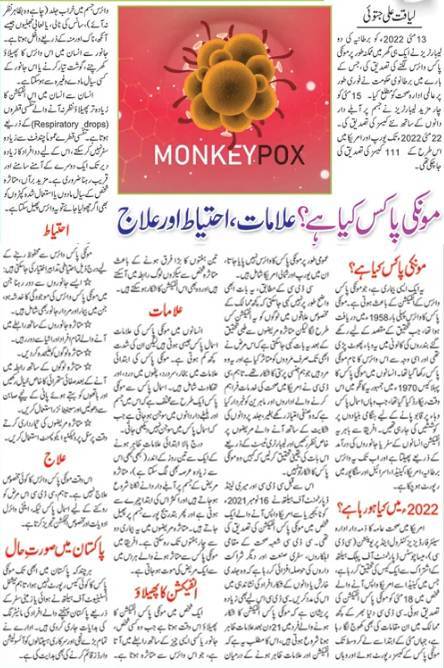Everything You Need to Know About Monkey Pox in English & Urdu Languages
Monkeypox is a rare viral disease that is similar to smallpox. It is found mostly in Africa and can be deadly in humans. The monkeypox virus is usually spread to humans from contact with an infected animal such as a monkey, rat or squirrel. It can also be spread from person to person through close contact such as touching or sharing bedding or clothing with someone who is infected. Symptoms of monkeypox include fever, headache, muscle aches and a rash that starts on the face and spreads to the rest of the body. There is no specific treatment for monkey pox in allopathic medical science, but people with the disease should get rest and drink plenty of fluids to help their bodies fight the infection. In this post we shall share very useful information about monkey pox both in Urdu and English languages.
Monkeypox in Pakistan
There is a great danger of spreading epidemic of monekeypox in world in 2022 as lot of it cases already have been reported in many countries of the world including Pakistan. At the time of writing this article 3 cases of monkey pox have been already reported in Pakistan. Only in UK about 300 suspected cases of monkey pox have been reported. Pakistan need to take serious steps for avoiding the breakthrough of monkey pox through the travelers from the foreign countries.

What You Need to Know About Monkeypox?
Monkeypox is a viral infection by nature that is very much similar to smallpox. However monkey pox is generally less severe than smallpox and has a lower mortality rate. There is no specific treatment for monkeypox, but patients can receive supportive care to help relieve symptoms. Vaccination against smallpox can also help protect against monkey pox.
What is Monkeypox?
Monkeypox is a rare viral disease that occurs mostly in remote parts of Central and West Africa typically near tropical rain forests. The monkey pox virus is closely related to the human smallpox virus but generally produces a milder illness in people. Infection with the monkeypox virus does not confer immunity to smallpox. The last outbreak of monkey pox in the United States occurred in 2003 when there were 37 reported cases all in the Midwest. Now again in 2022 this virus is spreading quickly in many countries of the world.
What Causes Monkeypox?
Monkeypox is caused by the monkeypox virus, which is a member of the Orthopoxvirus genus. This virus is closely related to the smallpox virus and both viruses can cause a similar kind of disease in humans. Monkey pox is most commonly found in Africa where it is thought to circulate among rodents and monkeys. Humans can become infected through contact with an infected animal or through contact with the body fluids or lesions of an infected person. The disease is typically spread through close personal contact such as caring for an infected individual or sharing bedding or clothing. In some cases monkey pox has been spread through the handling of infected bush meat.
Symptoms of Monkeypox
The symptoms of monkeypox are similar to those of smallpox although they are usually less severe. Monkeypox begins with a fever followed by a rash that spreads from the face to the rest of the body. The rash starts as small red bumps and eventually turns into fluid-filled blisters. Other symptoms include headache, muscles pain and swollen lymph nodes. Monkeypox is usually not fatal, but it can be deadly in young children and people with weak immune systems. There is no direct treatment for monkeypox but hospitalization and supportive care can help to prevent complications.
Diagnosis of Monkeypox
It is thought to be transmitted from animals to humans although the exact method of transmission is not known. Symptoms of monkeypox include severe fever, headaches, muscle aches and a rash that spreads from the face to the rest of the body. The rash eventually forms blisters and scabs. Monkeypox is diagnosed based on these symptoms and a history of exposure to the virus. PCR test is used for diagnosis of monkey pox, the disease usually resolves on its own within a few weeks.
How To Prevent Mokeypox?
The best way to prevent monkeypox is to avoid contact with infected animals particularly wild rodents and primates. If you must handle these animals wear gloves and a mask. You should also avoid contact with the blood body fluids or skin lesions of any individual known or suspected to have monkeypox. In addition you should get vaccinated against smallpox. The smallpox vaccine is not 100% effective, but it can help reduce your risk of monkey pox if you are exposed to the virus.
Treatment of Monkeypox
There is no any exact treatment for monkeypox, but the symptoms can be treated individually with different medicines. Treatment may include:
1- Antibiotics to treat secondary bacterial infections
2- Pain relievers
3- Fluids and rest
4- Symptomatic care such as oatmeal baths for the rash
Hospitalization is often necessary to ensure that the patient is receiving adequate hydration and nutrition. In severe cases patients may require mechanical ventilation. There is currently no vaccine available for avoiding monkeypox virus and disease. In homeopathy mercsol, ars alb, dulcamara, graphities and sulphur are top five medicines for treatment of this disease. Biochemic medicine silicia is also helpful in many cases.
Conclusion
Monkeypox is a rare viral disease that is similar to human smallpox. The Monkey pox virus is found in animals including monkeys and can be spread to humans. The first recorded outbreak of Monkeypox occurred in the 1970s in Zaire (now the Democratic Republic of Congo). The most recent outbreak was in Pakistan in 2022. There is no specific treatment for Monkey pox and it can be fatal in up to 10% of cases. The best way to prevent the disease is to avoid contact with infected animals or humans. There is also a vaccine for human smallpox which offers some protection against Monkey pox. Ok, now read all about monkeypox in Urdu language;
Lumpy Skin Disease in Cattle, Symptoms, Causes, Diagnosis, Precautions, Treatment-Pakistan
Monkeypox Symptoms, Causes, Diagnosis, Prevention & Treatment (Urdu & English)

I am a professional content writer and have experience of 10 years. I also launched first ever English monthly magazine of human rights in Pakistan. Majority of content on this website is written by me.

